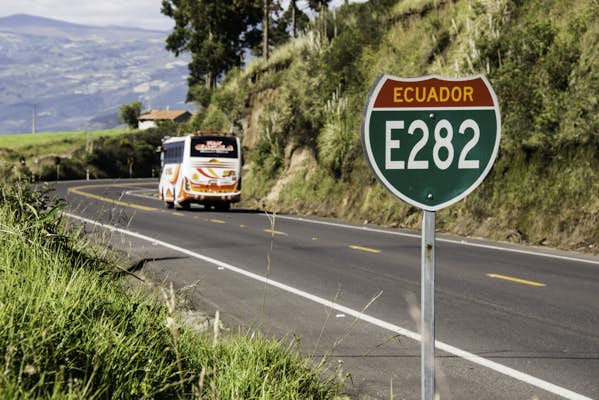
The rugged Andes and tracts of impenetrable rainforest present formidable barriers to overland travel in Ecuador.
But journeying through this dramatic topography is just one of the many reasons to come here. Getting around in Ecuador won’t always be quick, but it will always be an adventure.
The good news? Transportation in Ecuador is generally inexpensive, particularly if you stick to the buses, though prices ramp up dramatically if you include the Galápagos on your itinerary. Transit is easier on the mainland – wherever there are roads, you can pretty much guarantee that there’ll be a spluttering local bus to take you to your next destination.
From taking the bus to renting a car, here’s what you need to know to safely find your way in Ecuador.
Bus travel is the easy option in Ecuador
The bus – the beast of burden favored by many South American nations – reigns supreme in Ecuador. If there’s a road, whether it’s paved or gravel, it’s likely that some lavishly decorated rattletrap bus will be waiting to take you down it. On routes between larger cities, you can often take a comfortable modern coach – these luxe buses have become much more common in recent years, replacing many of the wheezing old buses on long-distance routes. Air-con, reclining seats, Wi-Fi and onboard movies usually come as standard.
As is often the case in the Americas, bus travel offers some colorful insights into the lives of ordinary Ecuadorians. A long bus ride is a great way to meet and speak to local people (expect your own apparel to feel decidedly dull next to the felt hats and colorful shawls of your fellow passengers).
Need some hand-holding before jumping onto a local bus? Ecuador Hop is a gringo-friendly, hop-on-hop-off bus service with a variety of routes and passes, traveling to destinations across the country; what you lose in local color, you make up for with convenience. Ditto Wanderbus Ecuador, although the itineraries are slightly more rigid.
Alternatively, head to the nearest public bus station with your Spanish phrasebook and go it alone. In most towns and cities, the bus terminal – typically called the Terminal Terrestre – is on the outskirts, with regular services to almost anywhere. If you’re in a hurry and want some creature comforts, make sure you book onto an autos de lujo, one of those modern coaches with all the mod-cons.
 Quito is connected by road to destinations across the country © Victor Vargas / 500px
Quito is connected by road to destinations across the country © Victor Vargas / 500px
Hiring a car gives you the freedom to explore
If you enjoy the freedom of the open road and being in charge of your own destiny, you could always rent a car in Ecuador. Your home license is usually sufficient for renting a vehicle (you’ll also need your passport), but if you get stopped by the police you may face less hassle if you have an international license.
The backbone of the country’s road network is the Pan-American Highway, which broadly follows the Avenue of Volcanoes; a chain of eight snow-capped peaks that runs down the spine of Ecuador. Remember to keep your eyes on the road – the scenery is pretty spectacular!
Most of the main highways are in good repair, but road conditions deteriorate significantly when you peel off onto minor roads, so consider hiring a 4WD. Most of the usual international rental agencies are present at airports and downtown in major cities. Petrol is cheap by international standards, but bear in mind that some roads have tolls, which can drive up costs.
The weather can change quickly in Ecuador and landslides are not uncommon during downpours, so check the forecast before setting off. Local bus and truck drivers show limited respect for road rules and the country has one of the highest rates of road accidents in Latin America; traveling by motorbike is only for the brave and experienced.
Taxis are handy for urban travel in Ecuador
Given how extensive and affordable the buses are, it’s unlikely that you’ll be taking a taxi for intercity travel. However, most towns and cities have them and they can be useful for exploring and for short hops out of town to outlying sights. Ecuador’s taxis are usually yellow, but only taxis in major cities tend to be metered. While drivers tend to be honest, it’s worth agreeing on a price before setting off.
 The scenery of the Amazon is almost as spectacular from the air as it is at ground level © Gustavo Frazao / Shutterstock
The scenery of the Amazon is almost as spectacular from the air as it is at ground level © Gustavo Frazao / Shutterstock
Save time with an internal flight
Viewed from the sky, Ecuador really is something to behold. The Andean landscape is pockmarked with volcanoes that tumble towards the jungle, which makes for quite a spectacle when seen from above (providing the clouds play ball). The views are one of the perks of flying in Ecuador, although the melting glaciers below may persuade climate-conscious travelers to stick with the buses.
Unless you have lots of time and money at your disposal, you’ll need to fly to get to the Galápagos Islands and probably also the Amazon rainforest (although long-distance buses can take you to some areas). LATAM and Avianca are the main domestic carriers.
There’s not much accessible transportation in Ecuador
Like much of South America, Ecuador places significant obstacles in the path of people with disabilities, from uneven sidewalks without ramps to steps at the entrances to public buildings and hotels. Few long-distance buses are wheelchair accessible, so you may need to forego travel by road and take to the skies instead to traverse the country.
Though the rules are not always followed, long-distance buses are supposed to carry disabled passengers for free, and disabled travelers also get discounts on internal air travel. Alternatively, you could book an accessible tour through a company such as Latin America For All to overcome some of the challenges that travelers with disabilities face in Ecuador. For more information, see Lonely Planet’s Accessible Travel Resources.



